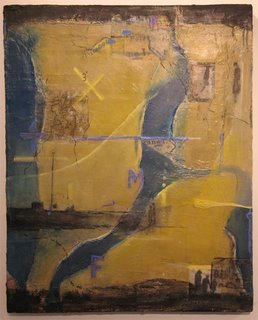The art of crossing borders
City Gallery
994 State St., New Haven, (203) 782-2489
Jane Harris & Sheila Kaczmarek: Borders and Intersections
Ends Nov. 19, 2006.
Artists Jane Harris and Sheila Kaczmarek, sharing the City Gallery space for Borders and Intersections, have collaborated in the past. This show features individual works. The title refers both to their past methods of working together—finding areas of commonality and points of difference—as well as their shared aesthetic interests in edges and the overlaying of forms and colors.
In Kaczmarek's series "Gwen's Beach," she plays four variations on a theme. The primary image is of a shore landscape, from an old photograph taken by her grandmother of a beach in her English hometown. The beach is populated in the foreground by summer vacationers. A large outcropping of rocky cliffs looms in the background. In the most readable pho
 to, part of "Gwen's Beach 3," we see the waves rolling in or out, the sun glinting off the foam.
to, part of "Gwen's Beach 3," we see the waves rolling in or out, the sun glinting off the foam.By printing the image or sections of the image in multiple ways and on different surfaces and overlapping those prints, Kaczmarek takes a single moment and renders it almost cinematic (in a post-1950's French art film sort of way). In extreme blowups of small groups of people, the figures become indistinct blobs of shadows, representations of the "idea" of vacationers, rather than individuals. The mottled grain of the paper and the accumulated dust and scratches of the years are accented. They become abstract tonality. A Xerox transfer print of the shore looks almost like a charcoal drawing. A place once solid—filled with the sound of summer joy, the crash of waves, sand grit and ocean wind—is now all but lost to the past. The border between land and water is as shifting and contingent as the line between memory and forgetting.
Some of the images of the beachgoers cropped up in Kaczmarek's other works, mixed media paintings based on nautical charts or maps. Her four "Sea Charts" are composed on rough fired clay "canvases." Sea charts, blown up and enhanced in a computer and collaged on the hard clay surface, were covered with encaustic, a hot wax medium. They become like runes, hieroglyphics, with their specialized markings. "Stony Beach" and "Eel Pond" are similar works, on wood rather than clay, employing collaged text and maps. Based on actual maps, they show channels of water squeezing through two brown land masses. The application of paint and materials, including encaustic, enhances the effect that one is viewing an actual landscape. The blues of the water—light and curdling in "Stony Beach," dark and turbulent in "Eel Pond"—read, respectively, as warm and cold.
Kaczmarek also is showing three interesting clay works, natural forms bursting with unruly tendrils made of guitar strings.

Where Kaczmarek's works nod toward representation, Harris is determinedly abstract. She told me, "If I see anything in it, I try to get rid of it." (She did add that she likes adding photos to some of her monotypes.) With the series she is showing here, Harris made multiple prints using a repeated design. She works within a narrow color range. Most of the plates were inked up with one color and selectively accented with a brighter color. After the ink was applied Harris brushed, scratched and rubbed off ink to vary the tonal range.
Take some time with Harris' monotypes and they have a rich illusion of depth. The extent to which she works over the ink and adds marks or collage afterwards adds to the visual interest. On one print, she applied encaustic to partially obscure the collaged photos. Others have rubber-stamped lettering. Some have pencil scribbling along the bottom edge-not really a signature, but perhaps a signature line. On the other hand, there are grid or crosshatched lines inscribed in some of them that I found distracting and unappealing.
Borders and Intersections closes Nov. 19.

0 Comments:
Post a Comment
<< Home